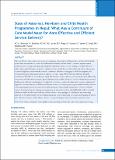Please use this identifier to cite or link to this item:
https://hdl.handle.net/20.500.14356/1980Full metadata record
| DC Field | Value | Language |
|---|---|---|
| dc.contributor.author | K C, A | - |
| dc.contributor.author | Bhandari, A | - |
| dc.contributor.author | Pradhan, Y N | - |
| dc.contributor.author | KC, N P | - |
| dc.contributor.author | Upreti, S R | - |
| dc.contributor.author | Thapa, K | - |
| dc.contributor.author | Sharma, G | - |
| dc.contributor.author | Upreti, S | - |
| dc.contributor.author | Aryal, D R | - |
| dc.contributor.author | Dhakhwa, J R | - |
| dc.contributor.author | Pun, A | - |
| dc.date.accessioned | 2023-06-04T09:41:33Z | - |
| dc.date.available | 2023-06-04T09:41:33Z | - |
| dc.date.issued | 2011 | - |
| dc.identifier.citation | CA. K., BhandariA., PradhanY. N., KCN. P., UpretiS. R., ThapaK., SharmaG., UpretiS., AryalD. R., DhakhwaJ. R., & PunA. (2011). State of Maternal, Newborn and Child Health Programmes in Nepal: What May a Continuum of Care Model Mean for More Effective and Efficient Service Delivery?. Journal of Nepal Health Research Council. https://doi.org/10.33314/jnhrc.v0i0.265 | en_US |
| dc.identifier.issn | Print ISSN: 1727-5482; Online ISSN: 1999-6217 | - |
| dc.identifier.uri | http://103.69.126.140:8080/handle/20.500.14356/1980 | - |
| dc.description | Special Issue Articles | en_US |
| dc.description.abstract | Abstract The cost-effective interventions exist across the continuum of maternal to child survival at each level of the health system that can contribute to achieve the Millennium Development Goals 4 and 5. However, implementation inefficiency, low coverage and equity gaps along this continuum remain a serious challenge to Nepal’s efforts to achieve these goals. This paper proposes a continuum of care model; discusses the readiness of policy and programs to provide high impact interventions across the continuum; identifies existing gaps in MNCHN programs; and recommends policy and program actions to improve coverage, equity, effectiveness and efficiency along the continuum of MNCHN service delivery in Nepal. The literature review includes systematic desk review, followed by discussions and deliberations amongst a group of professionals and MNCH experts in Nepal. Within the government health system in Nepal, a continuum of care approach is feasible, as policies and plans exist to ensure an integrated approach across the maternal to child care continuum. However, health programs largely remain vertically oriented. Achieving integration across the maternal to child continuum of care remains a challenge at each level of health system. An integrated system of program management for maternal, newborn and child health would be a feasible solution to enable an efficient and effective delivery of intervention packages. A collaborative and partnership approach to strengthen health systems, building managerial capacity, improving governance and engaging the private and civil sectors remains vital to achieve effective coverage and improve equity across the continuum of care. Keywords: Nepal, continuum of care, health systems, maternal, newborn and child health, equity and coverage. | en_US |
| dc.language.iso | en | en_US |
| dc.publisher | Nepal Health Research Council | en_US |
| dc.relation.ispartofseries | October;265 | - |
| dc.subject | Nepal | en_US |
| dc.subject | Continuum of care | en_US |
| dc.subject | Health systems | en_US |
| dc.subject | Maternal | en_US |
| dc.subject | Newborn and child health | en_US |
| dc.subject | Equity and coverage | en_US |
| dc.title | State of Maternal, Newborn and Child Health Programmes in Nepal: What May a Continuum of Care Model Mean for More Effective and Efficient Service Delivery? | en_US |
| dc.type | Journal Article | en_US |
| local.journal.category | Special Issue Articles | - |
| Appears in Collections: | Vol 9 No 2 Issue 19 October 2011 | |
Files in This Item:
| File | Description | Size | Format | |
|---|---|---|---|---|
| 265-Article Text-263-1-10-20130822.pdf | Fulltext Download | 2.08 MB | Adobe PDF |  View/Open |
Items in DSpace are protected by copyright, with all rights reserved, unless otherwise indicated.
